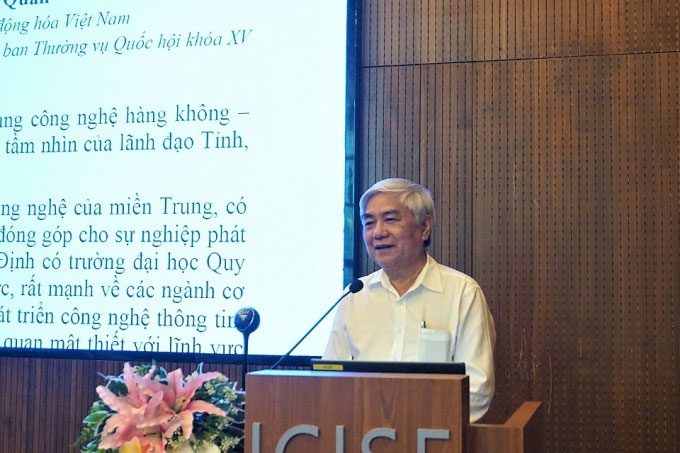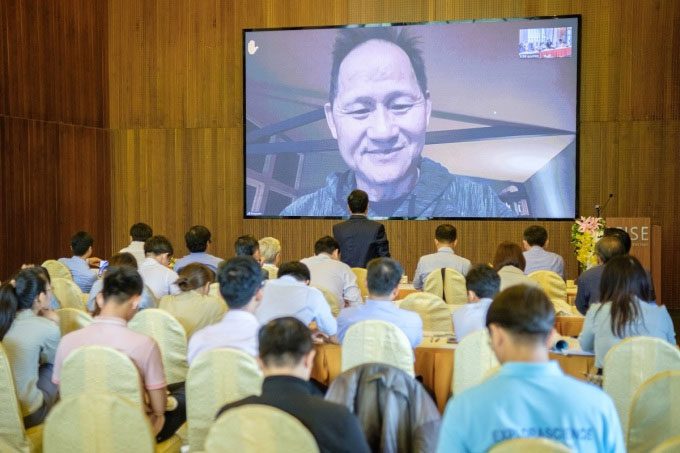Binh Dinh is consulting scientists to establish a Research and Application Center for Aviation and Space Technology in the region.
The topic was discussed during the seminar “Orientation for the Construction of a Research and Application Center for Aviation and Space Technology in Binh Dinh Province” held on November 21, organized by the Binh Dinh Department of Science and Technology in collaboration with the International Center for Interdisciplinary Science and Education (ICISE – Quy Nhon City).
According to experts, the plan to build a Research and Application Center for Aviation and Space Technology in Binh Dinh is a bold step but is entirely feasible, reflecting a strategic vision in anticipating the future trends of high-tech development.

The optical telescope located at the Science Discovery and Innovation Center is considered one of the largest telescopes in Vietnam today. (Photo: Thao Chi).
Nguyen Huu Ha, Director of the Binh Dinh Department of Science and Technology, believes that the orientation to establish the Research and Application Center for Aviation and Space Technology in Binh Dinh (the Center) is the right step. This aligns with the Government’s Strategy for the Development and Application of Space Science and Technology by 2030, as well as the Action Program of the Binh Dinh Provincial Party Committee.
Experts opine that Binh Dinh has many advantages for developing aviation and space technology research. The province is home to the Science Discovery and Innovation Center, one of the largest scientific exploration complexes in Southeast Asia. A notable feature is the astronomical observatory with a 0.6 m diameter optical telescope, with an aperture of f/6.5 – a telescope capable of conducting research projects at the undergraduate and postgraduate levels. This is not only a research tool but also a bridge between basic science and its applications.
In addition to the main telescope, the observatory also features various amateur telescopes and many supporting machines that assist in observing planets of the solar system and the galaxy. Binh Dinh’s favorable geographical location with flat terrain and proximity to the sea provides ideal conditions for building space research infrastructure.
Notably, ICISE plays the role of a “driving force” connecting leading scientists worldwide. The presence of specialized research groups, such as the neutrino physics group from the Interdisciplinary Science and Education Institute (IFIRSE), along with support from technology corporations like FPT and TMA, creates a multidimensional and dynamic scientific ecosystem.
Dr. Nguyen Quan, former Minister of Science and Technology and President of the Vietnam Automation Association, emphasized the necessity of establishing a systematic development roadmap. The focus should not be on scale, but rather on quality: prioritizing the development of human resources and concentrating on practical applications such as national defense, resource management, and disaster mitigation.

Dr. Nguyen Quan speaking at the seminar. (Photo: Thao Chi).
Professor Nguyen Dinh Duc, Vice President of the Vietnam Mechanical Engineering Association, suggested a unique approach – focusing on the research and development of small satellites. This could be a “sharp point” of technology that helps Binh Dinh make its mark in space research.
Dr. Nguyen Trong Hien from the SAGI Physics Group proposed forming a SpaceLab with a focus on human resource development and adopting a bottom-up approach, starting with essential yet modest technical tasks.

Dr. Nguyen Trong Hien from the SAGI Physics Group participating in the online seminar. (Photo: Thao Chi).
The leaders of the Department of Science and Technology stated that based on the contributions of experts, the local government has identified several directions for implementing the construction of the Center in line with the decisions of the Prime Minister and the provincial People’s Committee. The focus is on developing human resources, hiring capable consulting units to build reports, and proposing specific management and financial mechanisms to facilitate research activities, international cooperation, and attract high-quality experts.


















































